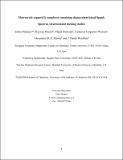Files in this item
Macrocyclic copper(II) complexes containing diazacyclam-based ligand : spectral, structural and docking studies
Item metadata
| dc.contributor.author | Mardani, Zahra | |
| dc.contributor.author | Moeini, Keyvan | |
| dc.contributor.author | Darroudi, Majid | |
| dc.contributor.author | Carpenter-Warren, Cameron | |
| dc.contributor.author | Slawin, Alexandra M. Z. | |
| dc.contributor.author | Woollins, J. Derek | |
| dc.date.accessioned | 2020-11-06T00:38:24Z | |
| dc.date.available | 2020-11-06T00:38:24Z | |
| dc.date.issued | 2019-11-06 | |
| dc.identifier | 263584947 | |
| dc.identifier | 15090914-8225-46fa-9845-5067c06bde36 | |
| dc.identifier | 000494601500001 | |
| dc.identifier | 85074817184 | |
| dc.identifier.citation | Mardani , Z , Moeini , K , Darroudi , M , Carpenter-Warren , C , Slawin , A M Z & Woollins , J D 2019 , ' Macrocyclic copper(II) complexes containing diazacyclam-based ligand : spectral, structural and docking studies ' , Journal of Coordination Chemistry , vol. 72 , no. 18 , pp. 3030-3045 . https://doi.org/10.1080/00958972.2019.1684477 | en |
| dc.identifier.issn | 0095-8972 | |
| dc.identifier.other | ORCID: /0000-0002-9527-6418/work/65014092 | |
| dc.identifier.other | ORCID: /0000-0002-1498-9652/work/65014114 | |
| dc.identifier.uri | https://hdl.handle.net/10023/20912 | |
| dc.description.abstract | The macrocyclic copper complex, [Cu(ACE)(NO3)2] (ACE = 1,3,6,10,12,15-hexaazatricyclo[13.3.1.16,10]eicosane), was synthesized by template condensation from a mixture of N1-(2-aminoethyl)-1,3-diaminopropane, formaldehyde and copper(II) nitrate. Replacement of the nitrate with thiocyanato and azido ligands gives [Cu(ACE)NSC]NSC ( 2 ) and the 1D-coordination polymer, [Cu(ACE)(μ-N3)]n[N3]n ( 3 ), respectively. Complex 1 , [Cu(ACE)(NO3)]NO3, is an intermediate product in which one of the nitrate ions is separated from its parent molecule. The formation of 1 allowed us to conclude that the mechanism of ion exchange in the parent molecule is similar to SN1. These complexes have been characterized by FT-IR spectroscopy and X-ray crystallography. In the crystal structures of 1 and 2 , the copper(II) ion has a distorted square pyramidal geometry in which the N4-donor ACE ligand lies on the equatorial plane and other ligand occupies the axial position. The copper(II) ion in 3 has an octahedral geometry, coordinating to one ACE ligand in the equatorial plane and two N-donor bridging azido groups in the axial positions. In all structures, owing to the Jahn-Teller effect, the coordinated bond length of the axial position is longer than the equatorial ones. The ability of the ACE ligand and its complexes 1 and 2 , along with their analogues, to interact with 10 selected biomacromolecules (BRAF kinase, CatB, DNA gyrase, HDAC7, rHA, RNR, TrxR, TS, Top II and B-DNA) was investigated by docking calculations and compared with that of doxorubicin. | |
| dc.format.extent | 16 | |
| dc.format.extent | 1343441 | |
| dc.language.iso | eng | |
| dc.relation.ispartof | Journal of Coordination Chemistry | en |
| dc.subject | Macrocycle | en |
| dc.subject | Diazacyclam | en |
| dc.subject | Copper complex | en |
| dc.subject | Template synthesis | en |
| dc.subject | Docking study | en |
| dc.subject | QD Chemistry | en |
| dc.subject | DAS | en |
| dc.subject.lcc | QD | en |
| dc.title | Macrocyclic copper(II) complexes containing diazacyclam-based ligand : spectral, structural and docking studies | en |
| dc.type | Journal article | en |
| dc.contributor.institution | University of St Andrews. School of Chemistry | en |
| dc.contributor.institution | University of St Andrews. EaSTCHEM | en |
| dc.identifier.doi | 10.1080/00958972.2019.1684477 | |
| dc.description.status | Peer reviewed | en |
| dc.date.embargoedUntil | 2020-11-06 |
This item appears in the following Collection(s)
Items in the St Andrews Research Repository are protected by copyright, with all rights reserved, unless otherwise indicated.

